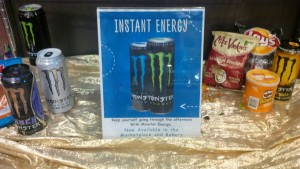
Last week I was stopped on the Jay by two young men sitting in the bed of a pickup truck. They weren’t townies or lost parents looking for directions. They were representatives from Monster Energy. They handed me a free can of Monster Rehab and sent me on my way.
Monster has become a part of our campus life. It was added to the dining locations and Thomson Store last year (made possible by Coca-Cola’s acquisition of the distribution rights).
Since then, you see at least one student per day with a Monster energy drink in hand, or cans piled in the resident hall trashcans after a Saturday night.
Now, Monster is clearly not good for you, at least not in large quantities. This might explain why Chartwells managers decided to place their encouragement to buy Monster underneath a shelf in front of the Hamilton-Williams Food Court cash registers; hidden from immediate notice, but still in sight. Though there is a “Balanced Living” sign outside the Food Court and numerous claims about healthy living on the Chartwells website, the company is marketing a blatantly unhealthy option; they tell us to gulp Monster while simultaneously contending that their main interest is in positive health choices.
According to the World Health Organization, there are numerous risks associated with the consumption of energy drinks like Monster. These include type 2 diabetes, caffeine overdoses and high blood pressure. These risks are compounded by the fact that the college students who drink Monster are typically under high stress and running on less sleep. Here, Chartwells’s ad becomes especially sinister: “keep yourself going.”
Even worse, when Monster is mixed with alcohol, something young adults do often, the chance for things like heart palpitations increases. Here’s where Monster Energy’s ad people come in. In New York state, Monster was accused of planting student “ambassadors” on campuses. They were told to throw parties encouraging their fellow classmates (including underage freshmen and sophomores) to use Monster as their exclusive alcohol mixer. According to ABC News, Monster paid these students some $100 per party.
But the issue at hand, for me, is not exclusively a health one. Consumers have been adequately informed about energy drinks, and I believe in a certain level of personal accountability in the marketplace. I don’t think that I am being unduly influenced or even taken advantage of by Monster. I know the risks associated, and I still, on occasion, chose to drink their product. What bothers me is the stand Monster and Chartwells seem to take on our generation.
The majority owners of Monster, both pushing 60, and the Chartwells public relations staff see our generation as shallow and easy to manipulate. Bring a shiny truck, whose jacked up wheels mirror their jacked up customers, and hand out free samples. The students will see how fun and young the Monster Energy company is (not necessarily healthy, but something close: youthful), and look for their flashy cans in refrigerators. Chartwells can promote green, ethical living, healthy options and globally conscious products, even when the company perpetuates the same issues they claim to be combating.
Advertisers see us as loud and vocal about our stances but not especially interested in practicing what we preach. It’s all about the tagline, the poster, the empty words that highlight and at the same time mask their hypocrisy. I am not condemning those who drink Monster, or even the company that prepares our food. But I wish they would stop pretending to be something they’re not.
